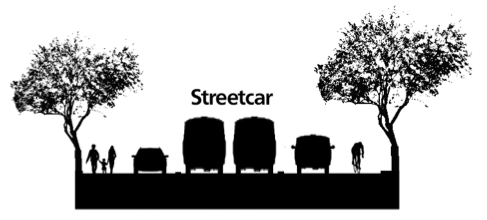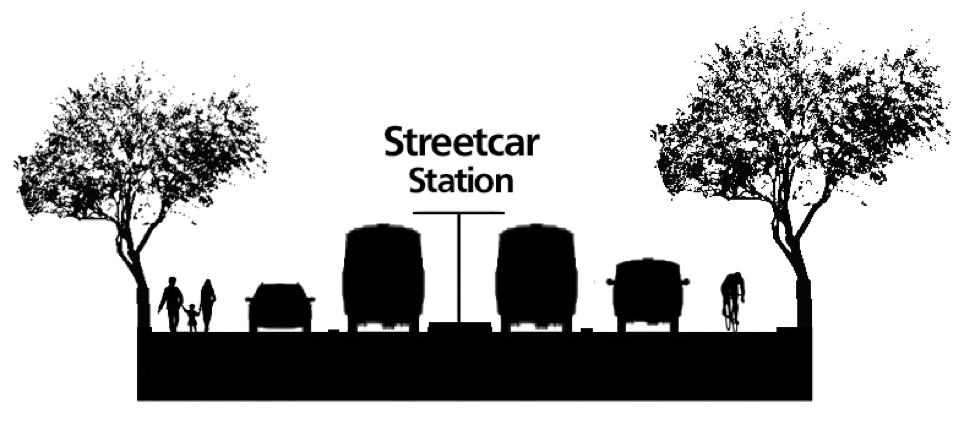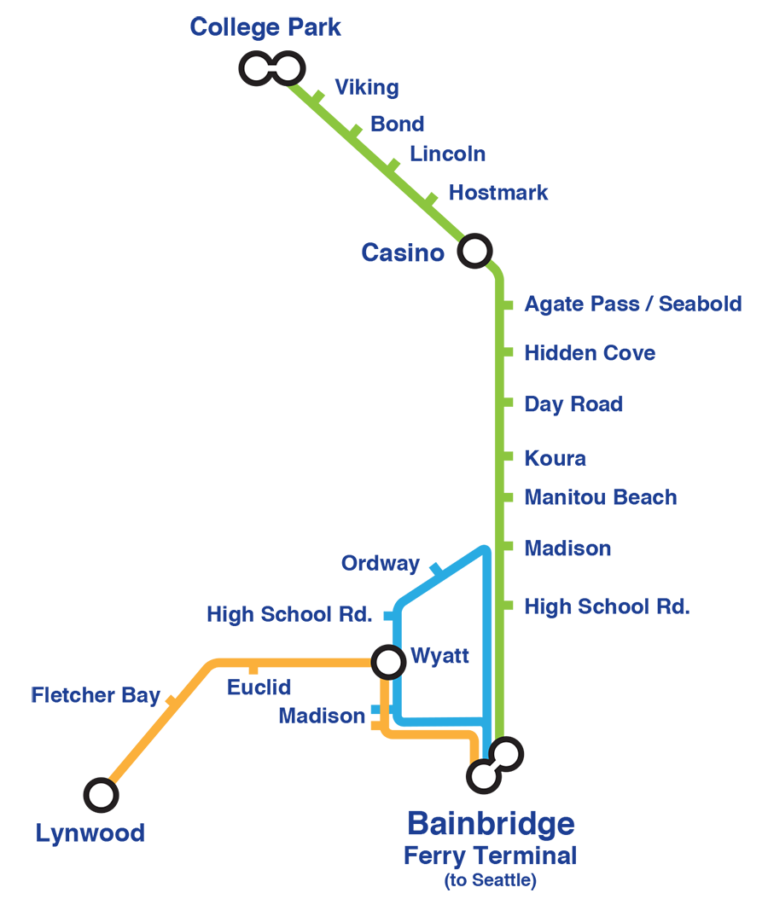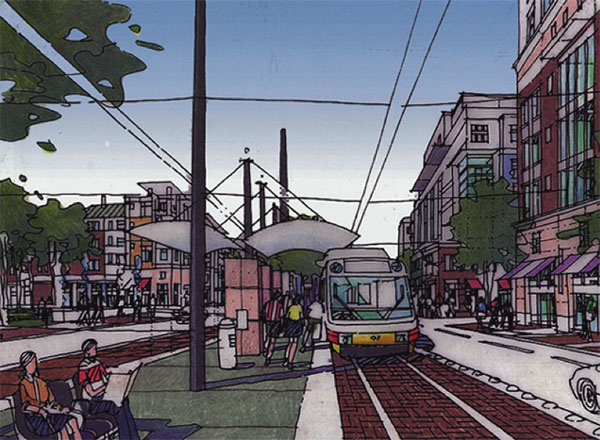This Kitsap Streetcar plan was conceived while commuting across Bainbridge Island, sitting in traffic on State Route 305. The goal of this plan is to address the growing traffic issues in North Kitsap County, specifically the seven miles of the Highway 305 corridor between the Bainbridge Ferry Terminal and Poulsbo. This plan also addresses the need for more flexible and frequent public transit.
During peak commuting hours, it can take up to 45 minutes to drive from the Bainbridge Ferry Terminal to the Agate Pass Bridge, due to excessive traffic, compared with 20 minutes in moderate traffic. Population growth on Bainbridge Island and across North Kitsap will only continue to aggravate this issue. A streetcar system on 305 can help commuters by-pass the traffic in 20 minutes, even during rush hour, while reducing environmental impact, maintaining the rural feel of the island, and increasing access to public transportation across the island and North Kitsap.

A study in 2006 looked at solutions specific to ferry commuters. A summary of those proposed solutions can be found in Appendix A. However, the growing traffic issues on Highway 305 go far beyond Bainbridge ferry commuters, encompassing workers commuting to and from Bainbridge Island to teach in the schools, to work in the stores, build and maintain the homes, to police the streets, as well as pass through to reach jobs in King County.
A comprehensive solution requires enticing drivers out of their cars and onto a public transportation option that is better than driving alone. There is a solution that fits the rural nature of Bainbridge Island and Kitsap County. A solution that worked for our great-grandparents’ over 100 years ago, and which can work for us, and our children, and their children.
In short, a lightweight, electric, streetcar network that can get us from home to work (or school) and back again, conveniently and easily.
Problem
The transportation problem goes beyond the ferry traffic and Agate Pass bottleneck. The problem is that there is no good alternative to an automobile for over 90% of the trips taken within the county.
Along the Highway 305 corridor, Kitsap Transit provides well-used bus service synchronized to the ferry schedule, but only for a few hours each morning and evening. If a Bainbridge resident wants to visit Winslow by bus, that trip needs to start and stop at 45-55 minute intervals, and must take place during either the morning or evening commutes. The same goes for a Poulsbo resident visiting Bainbridge Island or a Bainbridge resident visiting Poulsbo. That level of service is far too infrequent to attract any riders who are not also riding the ferry.
The 2002 Island Wide Traffic Study suggests that only 40% of the rush hour cars on Highway 305 originate from the ferry.[1] Ferry rider-ship has shrunk since 2002, yet the traffic on Highway 305 has increased.
Studies of ferry ridership have tracked the destinations of the ferry rides. As the chart shows, the majority of riders end their trips on Bainbridge Island. 25.3% end their trips in Poulsbo, North Kitsap, and Kingston. The remaining 7.3% in Central and South Kitsap. Thus a large number of drivers using 305 are not heading to or from the ferry.
Thus, the complete solution to Highway 305’s rush hour traffic must go beyond the needs of just ferry commuters, and incorporate all 305 transportation needs. A streetcar can do this.
A Solution

The term streetcar is used to refer to a public transportation system which consists of a single car which rides on a set of steel rails, powered by electricity. Streetcars tracks can be installed within the footprint and lanes of existing streets or can be installed on a purpose built roadway.
A streetcar is different from a light rail. Light rail system is much more expensive, has trains consisting of multiple cars, carries more passengers at one time, and runs far less frequently than a streetcar.
Streetcars are similar to buses. In contrast, light rail are more like subways and trains.
Rural Fit
A streetcar service is in keeping with the rural nature of Bainbridge Island and North Kitsap. The cars are small and unobtrusive. Stations consist of little more than a raised sidewalk. A two-way, double set of streetcar tracks is only slightly wider than a single, one-way lane of highway.
Streetcars are generally considered quaint, unlike light rail, which are generally considered heavy infrastructure, despite the name, and are more suitable for metropolitan and urban areas.
Capacity Fit
The Bainbridge ferry run has 5,000 daily commuters. Kitsap Transit provides rush-hour bus service for these commuters to and from the Bainbridge ferry to major intersections along Highway 305 on the island, park-and-ride lots in Poulsbo, Kingston, and Silverdale. Nine other Kitsap Transit bus routes support destinations on Bainbridge Island.
A single streetcar can hold a similar number of passengers as a small bus, and thus a handful of streetcars can meet the current capacity to service the highway corridor bus routes.
Speed Fit
Streetcars travel in their own lane, so can bypass the traffic. Thus, streetcars will be able to transport passengers from the ferry to Agate Pass Bridge in 15-20 minutes during rush hour, compared to a predicted 30-40 minutes for future car commuters and bus passengers.
How? Streetcars travel at up to 30-45 miles per hour. This is approximately the same speed as the automobile traffic on Highway 305 during peak hours, and much faster than the traffic when the highway is congested.
Highway 305 has no sharp curves and no major hills to climb or descend. This allows the full speed of the streetcar technology to be achieved.
In rush hour, the 7-mile drive from the Bainbridge Ferry terminal to the Agate Pass Bridge takes over 20 minutes. At least twenty days per year, it takes 30-40 minutes. The 2002 Island Wide Transportation Study predicts this average time to grow to 40+ minutes by 2022. A streetcar can make that same run in 15-20 minutes, traveling on dedicated tracks, with a top speed of 45 miles per hour, including traffic lights, and including time for unloading at multiple stops. The full 15-mile line from the Bainbridge Ferry Terminal to College Park in Poulsbo can be completed in 30-40 minutes.
Expandability
Individual streetcars are small, and thus capacity can be added in small increments. Streetcars on the same system can vary in size. They can be doubled up to double capacity. Capacity can be adjusted during the day to optimize the system for the expected rider-ship.
Outside of 305, Streetcar lines can be installed within existing roadways, to run inline with traffic. So in lower density neighborhoods and central business areas, additional lines can be built without widening the streets.
Comfort and Desirability
Streetcars use steel wheels running on steel rails. Rail provides for a far more comfortable ride than any bus. Streetcars run on electricity, providing smooth acceleration, smooth deceleration, and little vibration. In study after study of public transit options[1], the vast majority of riders prefer rail technology over buses.
Initial Line

The initial streetcar line (the Green Line) runs down the center of Highway 305, from the Bainbridge Ferry Terminal to the end of Highway 305 in Poulsbo in the College Park development.
Stops include all major intersections on the highway, including: the Bainbridge Ferry Terminal, High School Road, Madison, Manitou Beach, Koura, Day Road, Hidden Cove, Agate Pass / Seabold, the Casino, Hostmark, Lincoln, Bond, Viking, and College Park.
Center-of-305
A set of double streetcar tracks is about the width of one and a quarter highway lanes, 18-20 feet wide. Adding a streetcar line thus widens the highway, but less than adding more automobile lanes or dedicated bus lanes.

Each intersection where the streetcar picks up and drops off passengers will require some additional width for “stations”, which can be as simple as raised and covered sidewalks.
In between the stops on 305, the streetcar tracks do not need to be paved. They can be laid on a gravel roadbed. Thus the center streetcar lane adds to the safety of the highway by forming a divider between northbound and southbound traffic.
Streetcar traffic in the center of the highway can easily be interfaced with automobile traffic. Streetcars stop at the same traffic lights as automobiles. Left turn lanes can be situated on the left side of the tracks to minimize interactions of streetcars and automobiles at the road intersections.
Pedestrians today must cross the highway when traveling by bus, whereas with the streetcars in the center of the highway, pedestrians must cross only one lane of traffic to reach the loading/unloading zone. Unless lights are added to the unregulated intersections, crossing the highway will remain an issue, but crossing one lane of highway traffic is far easier and safer than crossing two.
Stations
Streetcars do not require stations. Stops require only an additional 4-6 foot wide concrete sidewalk in between the tracks to allow entry and egress to the cars. Such stops are only slightly more obtrusive than bus stops.

Given the wet climate, these sidewalks should be covered. Details such as comfort must be taken into account to entice ridership.
Frequency
Any new public transport solution on Highway 305 needs to include a plan for increased frequency. The existing Kitsap Transit 45-55 minute schedule works well with ferry riders, but it is inadequate to entice the 60% of highway traffic occupants who are not traveling on the ferry.
Ideally, the streetcar service would run every 10-15 minutes. This makes the average wait 5-7 minutes. This can be achieved by using small streetcars most of the time, and then adding more, larger streetcars to handle the peak ferry loads.
The stretch of Highway 305 to be serviced with a streetcar is 15 miles long, from the Bainbridge Ferry Terminal to College Park in Poulsbo. At a top speed of 45 miles per hour and an average of 30 miles per hour including traffic lights, loading, unloading, and intermediate stops, a single streetcar can traverse the entire line in 30-40 minutes. Thus five streetcars are sufficient to provide service every 15 minutes. A handful of additional cars synchronized with the ferry schedule would lower the average frequency between streetcars to 10 minutes during peak commuting times.
Feeder Routers
The streetcar line can be used to get passengers to more rural bus routes, as well. Today, nearly all of Kitsap Transit bus routes begin and end at the Bainbridge or Kingston or Bremerton Ferry Terminals. For the Highway 305 corridor, having a streetcar line makes it possible to move those bus stops out to the streetcar stops along the highway.
What this means is that we can have bus routes to more locations on the island, and so much more coverage, using the same number of buses and drivers. Instead of all bus routes starting and ending at the ferry (and thus being constrained in how far out they can travel before they must return to the ferry), buses will be free to run loops starting and ending at streetcar stations on Highway 305, such as Day Road, for example, and travel all around the north island neighborhoods. Ferry commuters could take the streetcar to the bus, and the bus to their front door.
The feeder buses thus become neighborhood transport systems. Shorter routes bypass the highway traffic entirely, further unclogging the highway while expanding access of public transit deeper into the outlying neighborhoods. A drawback might be more connections for commuters, but this is outweighed by a much shorter travel time overall.
A similar system is used successfully in Tokyo’s train system to maximize the coverage of the transportation network across that large city.
Park-and-Rides
The City of Bainbridge Island has a moratorium on new park-and-ride lots. At a minimum, the most popular stops for the streetcar should have free bicycle, scooter, and motorcycle parking. Such parking is well-used at the Bainbridge ferry terminal and can be used, in addition to the feeder bus routes, to increase streetcar ridership.
Additionally, Bainbridge and Poulsbo should consider additional car park-and-ride lots to further entice riders to ride the streetcar line. Ideally, there would be a park-and-ride at each of the stops along Highway 305, compared with just three intersections today (Day Road, Agate Pass Bridge, and Hostmark). This would allow the maximum number of riders to conveniently reach the streetcar line, minimizing the traffic traveling to and from existing park-and-ride lots.
Expansion Plan
Beyond the Highway 305 corridor, only a few neighborhoods merit a second street line at this moment in time. Expected population growth could change this, making transit access indispensable in the next 20-50 years. But suppose the population growth is moderate. Streetcars could be added as needed, and no sooner. A streetcar is the perfect quaint, affordable, and expandable solution.
A streetcar line, built within the existing city streets, could loop from the ferry terminal, across Winslow Way, up Madison, and back down the highway.

This “Blue Line” loop would service the vast majority of Winslow residents’ needs in reaching the central business district and ferry terminal, and allow riders coming down the main “Green Line” to reach the commercial districts of Winslow.
This latter point is crucial, since the majority of highway traffic is due to commuters coming to work at island businesses, teaching at the schools, policing the neighborhood, etc., and not riding the ferry.
As streetcar tracks can lie in existing roads, this line would not require any widening of streets. And since the Blue line is a one-way loop, tracks need to be installed only on the westbound lane on Winslow Way, northbound lane on Madison, and reusing the tracks on Highway 305 to complete the loop.

After Winslow, Lynwood Center is the next logical neighborhood for future expansion. Kitsap Transit currently provides no frequent, reliable bus service around Lynwood, making it difficult to travel there without a car. Like the Winslow loop, the “Orange Line” to Lynwood could be built in the existing roads, without adding any additional lanes. The Orange line would reuse part of the Winslow loop, branching off to Lynwood Center across Wyatt, around the Head of the Bay, and down Lynwood Center Road.
With this line, Lynwood could become a transit hub, with feeder bus routes extending to Crystal Springs, Pleasant Beach, and Fort Ward. Plus, given the simplicity of stepping on and off a streetcar, the neighborhoods along this line between Winslow and Lynwood would also be part of this line, similarly to how Kitsap Transit picks up and drops off passengers as needed along the bus routes today.

A Suquamish line, from the Agate Pass Bridge to the town of Suquamish, continued onward to Indianola Road and ending at the Kingston Ferry Terminal should be feasible as the population of North Kitsap expands. Such a line would connect these communities to Seattle with a known, reliable, and reasonable commute time, bypassing the traffic on Highway 305, and providing hourly passenger ferry service to Seattle via the existing Bainbridge ferry.
These four lines could cover the vast majority of North Kitsap County with a reliable form of public transit, with sufficiently frequent service to entice riders out of their cars.

This might look like a subway map, but remember these are small streetcars, where riders can hop on and off on their way to rural destinations. Unlike lightrail or four-lane highways, streetcars could enhance the ambiance and livability of our community, not undermine it.
Green Transportation
Streetcars are powered by electricity. Here in the Pacific Northwest, 60% of the electricity is produced from hydropower, and Washington State mandates at least 15% of the remaining power be produced from other renewable sources. This makes streetcars a far more green solution than automobiles or buses.
In addition to the direct savings on emissions, moving the feeder bus routes away from the ferry terminal (to meet the streetcar at the major intersections) will save additional fuel consumption. Having more park-and-rise will also shorten car rides.
Future Proof
Neither self-driving cars nor car-on-demand services like Uber can solve the problem of 5,000 commuters trying to reach an hourly ferry, plus thousands more commuting by car onto Bainbridge Island each day. There simply isn’t enough space on Highway 305 or drop-off space at the Bainbridge Ferry Terminal for everyone to travel in a single occupancy vehicle.
The streetcar system, as described, works well with these future solutions. The feeder bus routes could some day be replaced with self-driving vans or on-demand human drivers, who then drive only a few minutes from the streetcar line to the final destination.
Tourism
Bainbridge Island, Poulsbo and Kingston are all tourist destinations. The Kitsap Streetcar would serve these tourists, providing a means of transportation across North Kitsap, while potentially alleviating the 1-2 hour ferry waits on summer weekends.
Conclusions
The traffic on Highway 305 today costs the residents of North Kitsap County money in extended commutes, impedes the growth of the county, pollutes the environment, and aggravates our tourists.
This is a problem we’ve known about for the last decade, and one way or another we must solve it in the coming decade. Impeded or not, slow or fast, the population of the region continues onward, and with that growth will come more and more traffic.
It behooves us to discuss solutions to this problem, to understand the various options, and to plan for the moment when funding becomes available. We need alternatives to stopgap “solutions” like four lane highways that are cheaper upfront, but make the problem worse in the long run.
Of the known proposed solutions, a streetcar network best fits the rural, relaxed nature of Bainbridge Island and North Kitsap County. Even if the population growth is moderate, a streetcar network provides a viable long-term, environmental solution to North Kitsap County transportation










